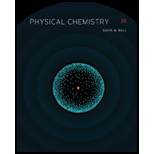
(a)
Interpretation:
The value of change in pressure required to get a value of
Concept introduction:
The Gibbs free energy of the system represents the maximum amount of non-expansion work achieved by a
Answer to Problem 4.60E
The value of change in pressure required to get a value of
Explanation of Solution
The number of moles of water is
The molar volume is
The required value
The change in Gibbs energy of the condensed system is represented as shown below.
Where,
•
•
Rearrange the equation (1) for the value of
Substitute the value of
Therefore, the value of change in pressure required to get a value of
The value of change in pressure required to get a value
(b)
Interpretation:
The value of change in pressure for
Concept introduction:
The Gibbs free energy of the system represents the maximum amount of non-expansion work achieved by a thermodynamic system at isothermal and isobaric conditions. The change in Gibbs free energy is used to predict the spontaneity of the process. The change in Gibbs energy of the gaseous system isrepresented as shown below.
Answer to Problem 4.60E
The value of change in pressure for
Explanation of Solution
The temperature of the ideal gas is
The temperature of the ideal gas in Kelvin is calculated as shown below.
The required value of
The number of moles of the ideal gas is
The change in Gibbs energy of the gaseous system is represented as shown below.
Where,
•
•
•
•
•
Rearrange the equation (3) for the value of
Substitute the value of
The above expression is further solved as shown below.
One is subtracted from both sides of the above expression.
When the initial pressure of an ideal gas is assumed to be
Therefore, the value of change in pressure for
The value of change in pressure for
(c)
Interpretation:
The difference between the two corresponding values of change in pressure is to be explained.
Concept introduction:
The Gibbs free energy of the system represents the maximum amount of non-expansion work achieved by a thermodynamic system at isothermal and isobaric conditions. The change in Gibbs free energy is used to predict the spontaneity of the process. The change in Gibbs energy of the gaseous system isrepresented as shown below.
Answer to Problem 4.60E
The value of change in pressure for
Explanation of Solution
The value of change in pressure for
The value of change in pressure for
The value of change in pressure for
The gases are easily compressible than a condensed phase system. A small increase in pressure is required for compression of gas and a large increase in pressure is required to compress water. Therefore, the compression of gas requires less pressure than the compression of water.
The value of change in pressure for
Want to see more full solutions like this?
Chapter 4 Solutions
PHYSICAL CHEMISTRY-STUDENT SOLN.MAN.
- Draw the products of the hydrolysis reaction between the ester molecule and water. Determine the products of the following reaction.arrow_forwardWhat is the unsaturation number for compounds with the formula C₂H₁₂Cl₂? O õ õ o o 4 3arrow_forwardIndicate the product obtained (formula). F3C. CF3 Br NH2 NH OMe K2CO3, DABCO, DMFarrow_forward
- What are the missing intermediates 1, 2, and 3? Please include a detailed explanation explaining the steps of malonic ester synthesis. Please include drawings of the intermediates and how they occur.arrow_forwardThe following intermediates are to proceed by acetoacetic ester synthesis. What are intermediates 1 and 2 plus the final product 3? Please include a detailed explanation and drawings of the intermediates and how they occurred.arrow_forwardThe chemical formula of "benzimidazole E" is C7H6N2. Draw it.arrow_forward
 Chemistry: Principles and PracticeChemistryISBN:9780534420123Author:Daniel L. Reger, Scott R. Goode, David W. Ball, Edward MercerPublisher:Cengage Learning
Chemistry: Principles and PracticeChemistryISBN:9780534420123Author:Daniel L. Reger, Scott R. Goode, David W. Ball, Edward MercerPublisher:Cengage Learning Chemistry for Engineering StudentsChemistryISBN:9781337398909Author:Lawrence S. Brown, Tom HolmePublisher:Cengage Learning
Chemistry for Engineering StudentsChemistryISBN:9781337398909Author:Lawrence S. Brown, Tom HolmePublisher:Cengage Learning Chemistry: The Molecular ScienceChemistryISBN:9781285199047Author:John W. Moore, Conrad L. StanitskiPublisher:Cengage Learning
Chemistry: The Molecular ScienceChemistryISBN:9781285199047Author:John W. Moore, Conrad L. StanitskiPublisher:Cengage Learning General Chemistry - Standalone book (MindTap Cour...ChemistryISBN:9781305580343Author:Steven D. Gammon, Ebbing, Darrell Ebbing, Steven D., Darrell; Gammon, Darrell Ebbing; Steven D. Gammon, Darrell D.; Gammon, Ebbing; Steven D. Gammon; DarrellPublisher:Cengage Learning
General Chemistry - Standalone book (MindTap Cour...ChemistryISBN:9781305580343Author:Steven D. Gammon, Ebbing, Darrell Ebbing, Steven D., Darrell; Gammon, Darrell Ebbing; Steven D. Gammon, Darrell D.; Gammon, Ebbing; Steven D. Gammon; DarrellPublisher:Cengage Learning Chemistry & Chemical ReactivityChemistryISBN:9781133949640Author:John C. Kotz, Paul M. Treichel, John Townsend, David TreichelPublisher:Cengage Learning
Chemistry & Chemical ReactivityChemistryISBN:9781133949640Author:John C. Kotz, Paul M. Treichel, John Townsend, David TreichelPublisher:Cengage Learning Chemistry & Chemical ReactivityChemistryISBN:9781337399074Author:John C. Kotz, Paul M. Treichel, John Townsend, David TreichelPublisher:Cengage Learning
Chemistry & Chemical ReactivityChemistryISBN:9781337399074Author:John C. Kotz, Paul M. Treichel, John Townsend, David TreichelPublisher:Cengage Learning





